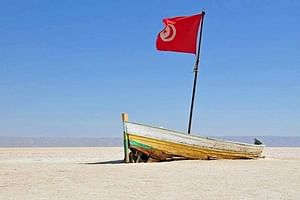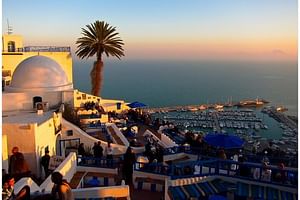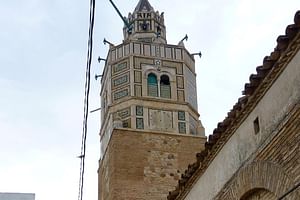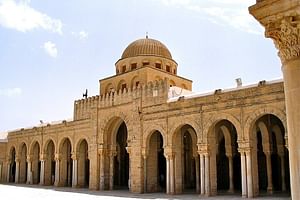-
Day 1
Kairouan_Tozeur
Kairouan_Tozeur
-
Day 1
The Great Mosque is the symbol of Kairouan. It is one of the oldest and most beautiful mosques in the world, one of the most impressive monuments in the whole Maghreb! Its religious prestige makes Kai...
The Great Mosque is the symbol of Kairouan. It is one of the oldest and most beautiful mosques in the world, one of the most impressive monuments in the whole Maghreb! Its religious prestige makes Kairouan the 4th holiest city in Islam. We admire its imposing minaret, its majestic courtyard with impressive dimensions, surrounded by superbly designed arcades and sheltering a sundial, and the high doors of richly carved cedar wood. They open onto the prayer rooms, adorned with dozens of marble columns. Built in 670, this architectural masterpiece, whose appearance evokes an adobe fortress, inspired other mosques in the Maghreb.
-
Day 1
The medina of Kairouan is one of the most preserved and authentic in Tunisia, where you can take a look in the souks, taste the pastries of Kairouan "Les Mekroudhs" and its artisanal manufacture of ca...
The medina of Kairouan is one of the most preserved and authentic in Tunisia, where you can take a look in the souks, taste the pastries of Kairouan "Les Mekroudhs" and its artisanal manufacture of carpets.
-
Day 1
Tozeur is the capital of the Bled El Jérid region, located in the south-west of the country, on the border with Algeria. Renowned for its immense palm grove, its succulent dates and the beauty of the...
Tozeur is the capital of the Bled El Jérid region, located in the south-west of the country, on the border with Algeria. Renowned for its immense palm grove, its succulent dates and the beauty of the architecture of its sun-baked brick houses and mosques, it is one of the jewels of southern Tunisia.
Known for the superior quality of its dates and mainly the "deglet ennour" variety, fingers of light, with transparent and succulent flesh, Tozeur essentially lives off its oasis economy: agriculture remains the main activity of the city. The oasis of Tozeur has more than three million palm trees, including 400,000 in the city, but also 200 springs. It is surrounded by dunes and a stone desert.
-
Day 1
Departure in horse-drawn carriages and walk in the Oasis of Tozeur, (included in the offer)
Departure in horse-drawn carriages and walk in the Oasis of Tozeur, (included in the offer)
-
Day 1
The Chak-Wak Tozeur Museum is an entertainment, entertainment and culture park, located in the heart of the largest palm grove in Tunisia, the oasis of Tozeur.
The Chak-Wak Tozeur Museum is a space o...
The Chak-Wak Tozeur Museum is an entertainment, entertainment and culture park, located in the heart of the largest palm grove in Tunisia, the oasis of Tozeur.
The Chak-Wak Tozeur Museum is a space of five hectares, fifty dinosaurs and a hundred animal, humanoid and human figurines, mini-museums, caves, huts, all scattered in lush oasis vegetation. The "Chak-Wak" is intended to be a reconstruction of the History of the Earth and of Humanity according to science and the different religions.
-
Day 1
One night in Tozeur Hotel 4*
One night in Tozeur Hotel 4*
-
Day 2
Tozeur_Douz
Tozeur_Douz
-
Day 2
Chebika is a mountain oasis located in the south of Tunisia, more precisely in the west of the governorate of Tozeur.
Chebika is a mountain oasis located in the south of Tunisia, more precisely in the west of the governorate of Tozeur.
-
Day 2
Tamerza or Tameghza is 14 kilometers north of Chebika, close to the border with Algeria, it was an ancient Roman and Episcopal defensive position in Byzantine times.
The road to Tamerza is winding. Al...
Tamerza or Tameghza is 14 kilometers north of Chebika, close to the border with Algeria, it was an ancient Roman and Episcopal defensive position in Byzantine times.
The road to Tamerza is winding. Along a large canyon it is 10 km long from Chebika. Its construction dates from the 2nd World War when Rommel, besieged by the allies, came from the North.
-
Day 2
It is in the Tunisian desert 14 km from Nefta and 38 km from Tozeur that Georges Lucas set his scene.
The place is magical and visitors went from curiosity to adventure.
Moreover, these same sets were...
It is in the Tunisian desert 14 km from Nefta and 38 km from Tozeur that Georges Lucas set his scene.
The place is magical and visitors went from curiosity to adventure.
Moreover, these same sets were used for the filming of episodes l and II of Star Wars (Star Wars).
-
Day 2
The basket of Nefta is a crevice in the form of a basket from which 152 springs emerged to irrigate the entire palm grove of Nefta. In the 1980s the springs dried up one after the other and there was ...
The basket of Nefta is a crevice in the form of a basket from which 152 springs emerged to irrigate the entire palm grove of Nefta. In the 1980s the springs dried up one after the other and there was desolation. The phenomenon was the same in El Hamma, Degache and finally Tozeur.
-
Day 2
The Chott Djerid salt lake is the largest saline plain or sebkha in Tunisia with an area of approximately 5,000 km2. It is the largest sebkha in the Maghreb.
The Chott Djerid salt lake is the largest saline plain or sebkha in Tunisia with an area of approximately 5,000 km2. It is the largest sebkha in the Maghreb.
-
Day 2
Douz is a city in the south of Tunisia known as the “gateway to the Sahara, where you will admire a quite superb Sunset of the Sahara; and you can, at the same time, enjoy the Sahara desert by a Qua...
Douz is a city in the south of Tunisia known as the “gateway to the Sahara, where you will admire a quite superb Sunset of the Sahara; and you can, at the same time, enjoy the Sahara desert by a Quad ride on the sand dunes, camel ride (optional)
-
Day 2
One night in Douz 4* hotel
One night in Douz 4* hotel
-
Day 3
Matmata_amphitheater D el Jem
Matmata_amphitheater D el Jem
-
Day 3
The city of MATMATA is located in the south-east of Tunisia, more precisely to the west of the city of Gabès. It is an ancient Berber village spread over the hills, identifying with the rocky landsca...
The city of MATMATA is located in the south-east of Tunisia, more precisely to the west of the city of Gabès. It is an ancient Berber village spread over the hills, identifying with the rocky landscapes, with a panoramic view at the top of the mountain and hiding one of the strange sites of Tunisia. The houses of this village are called troglodyte houses where you can admire the beauty of the underground dwellings in MATMATA. They are located in an underground pit in the form of caves, and each pit (الحوش) takes a circular shape and consists of a courtyard decorated with drawings and colors, and it consists of other rooms of the house, the rooms of the house with smooth mud. If you are a history lover, it is recommended to visit this beautiful village, which is visited by tourists from all over the world on daily tours to discover underground life and learn about the customs and traditions of its inhabitants.
-
Day 3
The amphitheater of El Jem is an exceptional testimony to Roman architecture, particularly that of monuments built for show purposes, in Africa. Located in a plain in the center of Tunisia, this amphi...
The amphitheater of El Jem is an exceptional testimony to Roman architecture, particularly that of monuments built for show purposes, in Africa. Located in a plain in the center of Tunisia, this amphitheater, built entirely of cut stone, is neither dug nor leaned against a hill. In this, it takes up the model of the Colosseum in Rome without however being a simple exact copy of the Flavian building. Its dimensions (long axis of 148 meters and short axis of 122 meters) and its capacity (estimated at 35,000 spectators) unquestionably rank it among the largest amphitheaters in the world.












